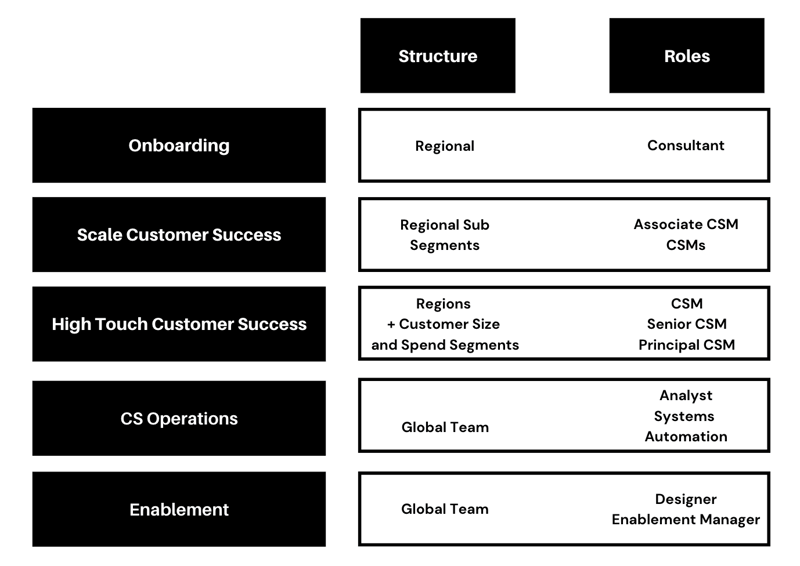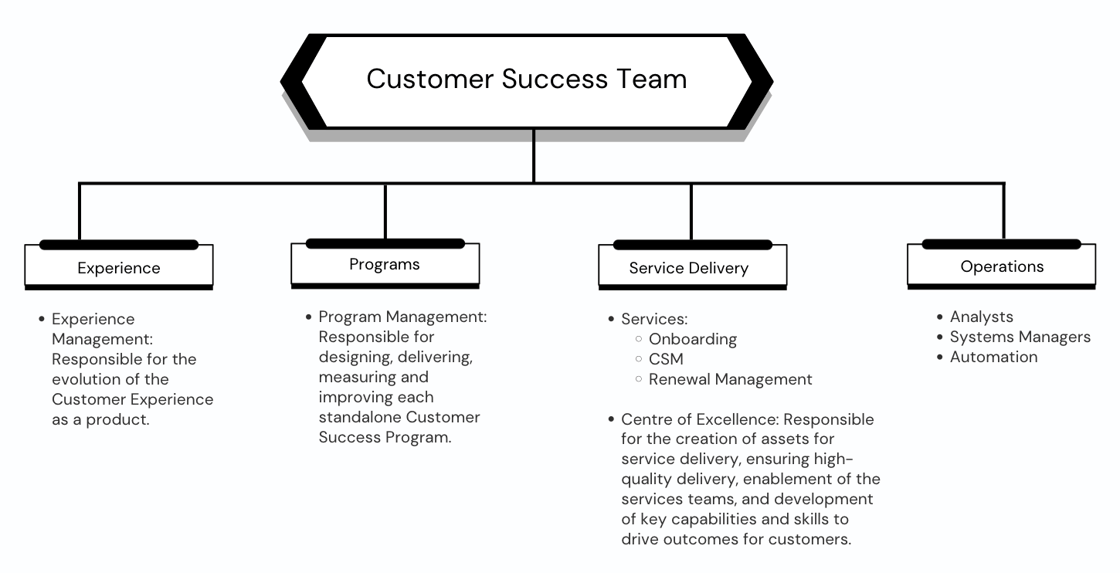#47: Redesigning CS Teams for Long-term Growth and Success
Old team structures are not likely to unlock new results.
We've taken for granted that Customer Success teams look like this:

As we enter 2024, we need to pause and reflect on a few important questions:
- Is this structure helping solve the challenges and opportunities we have ahead of us?
- Are we set up to drive value for customers most effectively?
- Are these roles providing the right level of expertise and ownership of results?
With the 2024 CS Trends in mind, I think the answer to these questions is NO.
When I look at how most CS teams are structured today, two things are clear:
- We are short on the expertise that helps us scale value delivery.
- We are working siloes, and it's hurting our customers.
A few weeks ago I wrote about 3 key roles to introduce to help scale your team, but we need to go beyond new roles and re-think how we structure our teams for scale.
Over the last few years, we've banked on CS Operations to solve all of our issues.
But even when we have the luxury of having a CS Operations team in place, much of the work needed to redesign how we service customers at scale is outside the scope of the operations teams.
Scaling value delivery isn't just about processes, systems and automation.
It's a combination of:
- measuring and communicating value for customers
- understanding the key drivers of success
- digging into the effectiveness of our programs and the correlations to customer outcomes
- defining an overarching digital strategy
- building and distributing content
- designing customer-first experiences
- redesigning assets, collateral and processes
Those roles don't all exist inside CS Ops today.
That means CS teams are often at the mercy of other departments. Continuously asking for favours to drive key initiatives that drive value for customers.
But how can you hold a team accountable for something they can't directly own?
Here's an example:
Let's say your goal is to build a Customer Education Programme that drives adoption and delivers on customer outcomes at scale.
Some of us are lucky to have Customer Education teams. But in most companies, it's unclear whether Marketing, Product or Customer Success owns this.
The result is multiple teams running disjoint webinars, email campaigns and in-app experiences with no clear strategy or ROI.
With Marketing's main mandate being demand generation (ie. leads), many of the marketing-led webinar programmes don't feel educational. They feel lightweight and sales-sy.
In the end, most customers don't get tangible value from these and stop showing up.
Then, CSMs pick up the task, taking on extra responsibility to build ad-hoc solutions to serve an ever-growing book of business. They run their webinars and newsletters to varying levels of quality and success. There are no clear metrics of success and business impact.
That's just an example of how today's siloed and limited structure creates a poor experience.
So what does the Customer Success organisation of the future look like?
Looking at the growing pains we're all feeling, I predict we will need:
- overarching roles across the Go-To-Market to create better experiences
- more program roles to drive innovation and excellence at scale
- more ownership of assets and resources required to deliver impactful engagements
If I was designing my first Customer Success team from the ground, here's what it might look like:

#1 Customer Experience Team
Most CX is fractured because there are teams across the customer journey rolling out experiments and initiatives that serve their unique interests, without consideration for what else is happening in other areas.
It's common to see an email campaign going out from sales, positioning a new product, at the same time that customer success is targetting the customer with educational content, and a survey for feedback.
All of which the customer is likely to ignore, because of the volume of non-relevant content they get regularly.
Introducing an overarching CX function, responsible for mapping and managing the customer experience is a great way to unify and align the go-to-market teams, while delivering a better overall experience to the customer.
If we think about the Customer Experience as a product, this function acts as the Product Manager for the Customer Experience. Prioritising the top improvements and managing a CX roadmap to communicate the top changes to the organisation.
One of the exciting things here is that this function can expand "Customer Experience" beyond the decision-maker, creating space to think about the journey and interest of the different personas of every customer account.
#2 Program Teams
Instead of expecting programs to be run by over-stretched CSMs and managers, CS Leaders should prioritise and invest in the key programs that support and scale the customer journey (ie. Customer Education, Outcome Realisation etc) and staff these initiatives with teams that can create and consistently improve the delivery of those programs to customers.
This might mean hiring for specific skills or gaining commitment from other teams to have team members dedicate a % of their time to these programs each year and have their performance attached to the success of the initiatives.
A benefit of having individual programs is the hyper-focus it creates. It also accelerates the rate of experimentation and innovation and brings accountability for results.
A lesson from the last decade of customer success is that your CSMs shouldn't be the only "distribution" channel for these programs. Otherwise, CSMs will be overwhelmed by the level of change being rolled out and will be unable to adopt all the new initiatives.
Modern programs should be geared towards scale and have the power to work with the CX Manager on direct distribution through the product, email, social etc.
#3 Centre of Excellence Supporting Services
Instead of multiple functions being responsible for the creation, measurement and improvement of the services delivered by Customer Success teams, a Centre of Excellence brings the ownership of processes, assets, skills and systems under one roof.
A great COE helps service teams scale their efforts without losing quality.
This is a common function for project and services teams that haven't yet become popular in Customer Success.
Whole not every team can afford a full COE team, but they can start building towards it by making it someone's clear responsibility.
TL’DR
We can't scale the results we deliver for customers simply by adding more CSMs or CS Ops roles. We need to rethink the functions needed in the Customer Success team.
Before hiring your next CSM, consider if that investment would yield further results in another area, while also building capacity for CSMs to serve customers more effectively.
I recommend introducing:
- Customer Experience Function: An overlay role acting as the PM of the experience.
- Program Teams: To deliver and measure the critical programs that support value delivery.
- Centre of Excellence Function: Helping improve the service we deliver to customers.
See you next year!
-3.png?width=200&height=88&name=This%20is%20growth%20(1)-3.png)
.png)
-1.png)
.png)